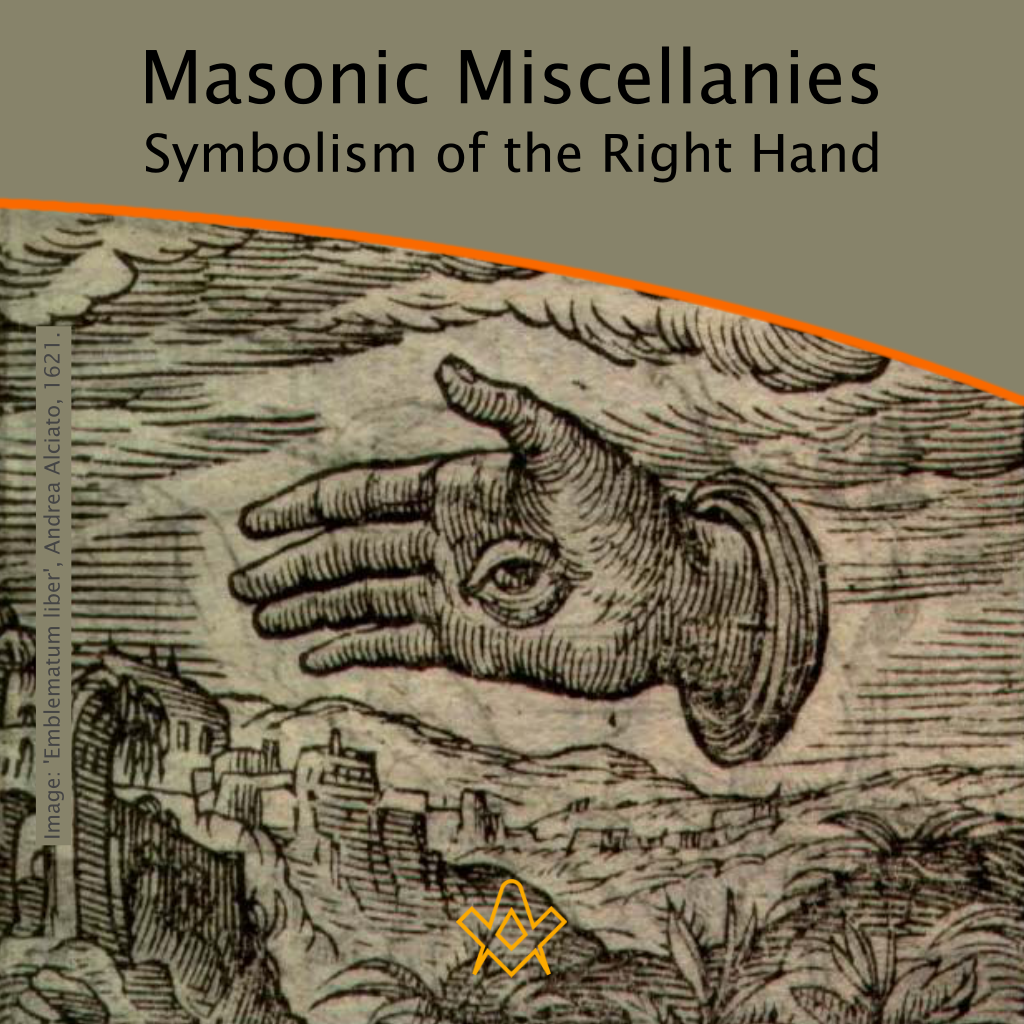The right hand is symbolic of authority, sovereignty, blessing, fidelity, and strength.
It is apparent that the use of the right hand as a token of sincerity and a pledge of fidelity, is as ancient as it is universal; a fact which will account for the important station which it occupies among the symbols of Freemasonry.
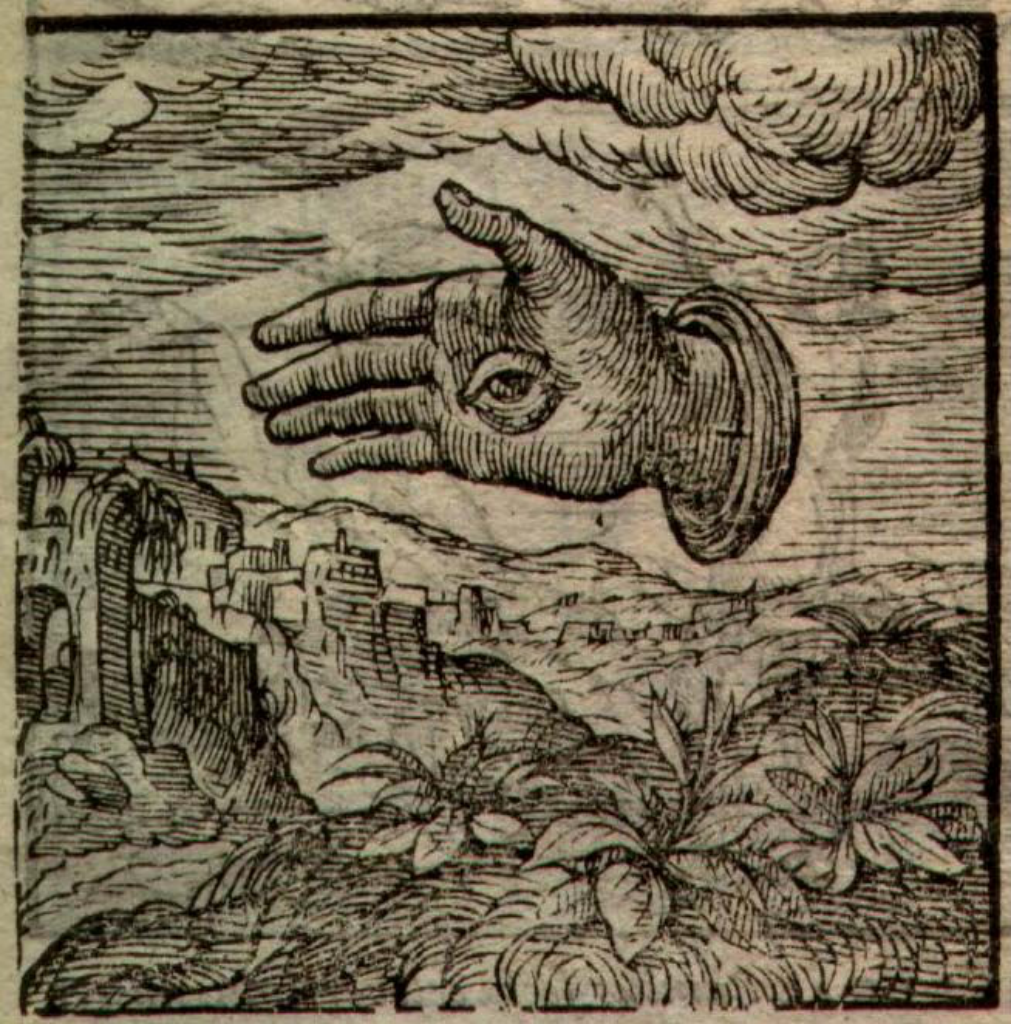
‘Emblematum liber’, Andrea Alciato, 1621.
IMAGE LINKED: wikimedia Attribution 4.0 International (CC BY 4.0)
There are many examples of the use of the term ‘right hand’ in religious and spiritual scriptures from across the world. In the Bible the words are used around 166 times.
Jesus said:
“from now on the Son of Man shall be seated at the right hand of the power of God”
(Luke 22:69)
The right hand has in all ages been deemed an important symbol to represent the virtue of fidelity. Among the ancients, the right hand and fidelity to an obligation were almost deemed synonymous terms.
Thus, among the Romans, the expression “fallere dextram”, that is to betray the right hand, also signified to violate faith; and “jungere dextras”, meaning to join right hands, and thereby to give a mutual pledge.
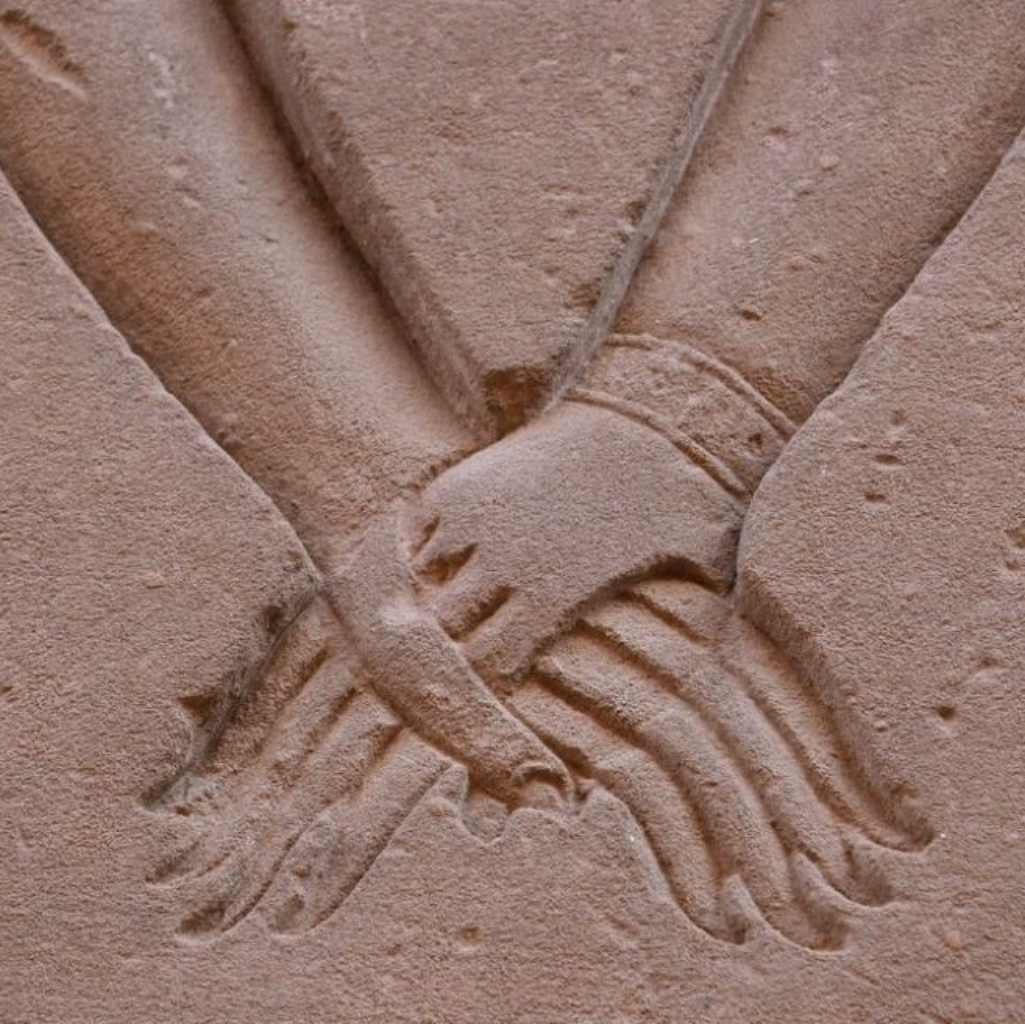
IMAGE LINKED: wikimedia Attribution 4.0 International (CC BY 4.0)
Among the Hebrews, יָמִין “yamin”, the right hand, was derived from אָמַן “aman”, to be faithful. The practise of the ancients was conformable to these peculiarities of idiom.
Among the Jews, to give the right hand was considered as a mark of friendship and fidelity.
Thus Saint Paul says (Galatians ii, 9);
“when James, Cephas, and John, who seemed to be pillars, perceived the grace that was given unto me, they gave to me and Barnabas the right hands of fellowship, that we should go unto the heathen, and they unto the circumcision.”
The same expression, also, occurs in Maccabees. We meet, indeed, continually in the Scriptures with allusions to the right hand as an emblem of truth and fidelity.
Thus in Psalm cxliv, it is said, “their right hand is a right hand of falsehood,” that is to say, they lift up their right hand to swear to what is not true.
This lifting up of the right hand was in fact, the universal mode adopted among both Jews and Pagans in taking an oath.
The custom is certainly as old as the days of Abraham, who said to the King of Salem;
“I have lifted up my hand unto the Lord, the most high God, the possessor of heaven and earth, that I will not take anything that is thine.”
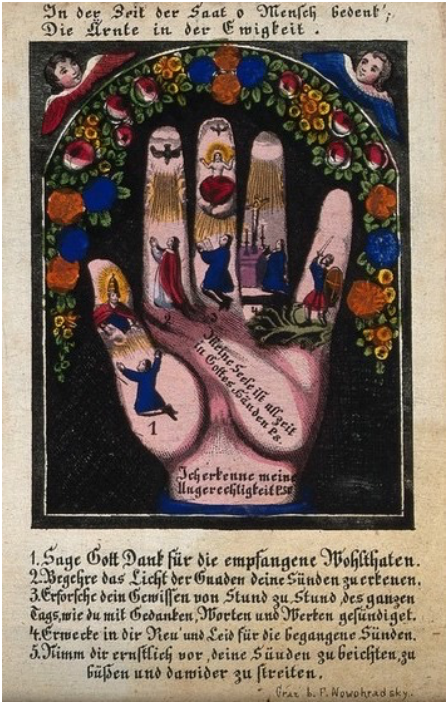
A hand with images of saints in the digits, as a mnemonic for good Christian conduct. Coloured engraving.
IMAGE LINKED: wellcome collection Attribution 4.0 International (CC BY 4.0)
Sometimes among the Gentile nations, the right hand, in taking an oath, was laid upon the horns of the altar, and sometimes upon the hand of the person administering the obligation.
But in all cases it was deemed necessary, to the validity and solemnity of the attestation, that the right hand should be employed.
Since the introduction of Christianity, the use of the right hand in contracting an oath has been continued, but instead of extending it to heaven, or seizing with it a horn of the altar, it is now directed to be placed upon the Holy Scriptures, which is the universal mode at this day in all Christian countries.
The antiquity of this usage may be learned from the fact, that in the code of the Emperor Theodosius, adopted about the year 438, the placing of the right hand on the Gospels is alluded to; and in the Code of Justinian (book ii, title 53, law i), whose date is the year 529, the ceremony is distinctly laid down as a necessary part of the formality of the oath, in the words “tactis sacrosanctis Evangeliis”, meaning the Holy Gospels being touched.
This constant use of the right hand in the most sacred attestations and solemn compacts, was either the cause or the consequence of its being deemed an emblem of fidelity.
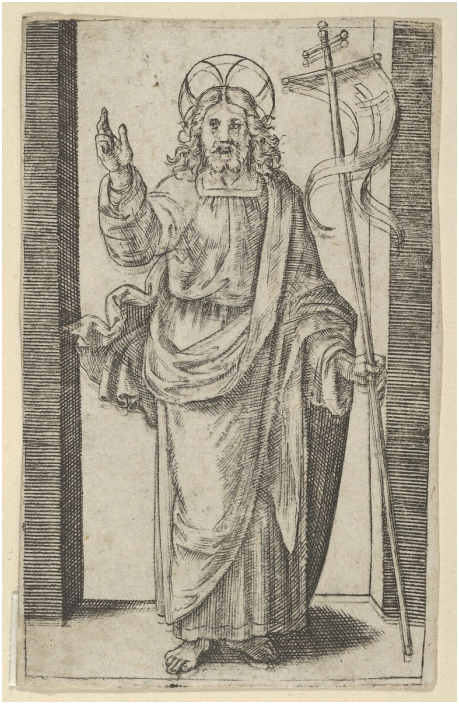
IMAGE LINKED: Met Museum Attribution 4.0 International (CC BY 4.0)
Doctor Potter (Greek Archeology, page 229) thinks it was the cause, and he supposes that the right hand was naturally used instead of the left, because it was more honorable, as being the instrument by which superiors give commands to those below them.
Be this as it may, it is well known that the custom existed universally, and that there are abundant allusions in the most ancient writers to the junction of right hands in making compacts.
The Romans had a goddess whose name was Fides, or Fidelity, whose temple was first consecrated by Numa.
Her symbol was two right hands joined, or sometimes two human figures holding each other by the right hands, whence, in all agreements among the Greeks and Romans, it was usual for the parties to take each other by the right hand, in token of their intention to adhere to the compact.
By a strange error for so learned a man, Doctor Oliver mistakes the name of this goddess, and calls her Faith. “The spurious Freemasonry,” he remarks, “had a goddess called Faith.”
No such thing. Fides, or as Horace calls her, “incorrupta Fides“, or incorruptible Fidelity, is very different from the theological virtue of Faith.
The joining of the right hands was esteemed among the Persians and Parthians as conveying a most inviolable obligation of fidelity.
Hence, when King Artabanus desired to hold a conference with his revolted subject, Asineus, who was in arms against him, he despatched a messenger to him with the request, who said to Asineus, “the king hath sent me to give you his right hand and security,” that is, a promise of safety in going and coming.
And when Asineus sent his brother Asileus to the proposed conference, the king met him and gave him his right hand, upon which Josephus (Antiquities of the Jews, book xviii, chapter ix) remarks:
“This is of the greatest force there with all these barbarians, and affords a firm security to those who hold intercourse with them; for none of them will deceive, when once they have given you their right hands, nor will any one doubt of their fidelity, when that is once given, when though they were before suspected of injustice.”
Stephens (Travels in Yucatan, volume ii, page 474) gives the following account of the use of the right hand as a symbol among the Indian tribes:
In the course of many spears’ residence on the frontiers including various journeyings among the tribes, I have had frequent occasion to remark the use of the right hand as a symbol, and it is frequently applied to the naked body after its preparation and decoration for sacred or festive dances.
And the fact deserves further consideration from these preparations being generally made in the arcanum of the secret Lodge, or some other Private place, and with all the skill of the adept’s art.
The mode of applying it in these cases is by smearing the hand of the operator with white or colored clay, and impressing it on the breast, the shoulder, or other part of the body.
The idea is thus conveyed that a secret influence, a charm, a mystical power is given, arising from his sanctity, or his proficiency in the occult arts.
The use of the hand is not confined to a single tribe or people.
I have noticed it alike among the Dacotahs, the Winnebagoes, and other Western tribes, as among the numerous branches of the red race still located east of the Mississippi River, above the latitude of 42 degrees, who speak dialects of the Algonquin language.
Extracted from pages 856-857, Mackey’s Revised Encyclopedia of Freemasonry, vol. 2, Mackey et al, Masonic History Company, Chicago, 1929.
Article by: Albert G. Mackey
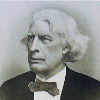
Albert Gallatin Mackey (1807 – 1881) was an American medical doctor and author.
He is best known for his books and articles about freemasonry, particularly the Masonic Landmarks.
In 1849 he established The Southern and Western Masonic Miscellany, a weekly masonic magazine.
He served as Grand Lecturer and Grand Secretary of The Grand Lodge of South Carolina, as well as Secretary General of the Supreme Council of the Ancient and Accepted Scottish Rite for the Southern Jurisdiction of the United States
Recent Articles: Masonic Miscellanies
 Masonic Miscellanies - The Amulet of the Ladder Explore the cosmic significance of the Ladder in ancient Egyptian mythology through Wallis Budge's "Egyptian Magic." Discover how this profound symbol bridges the mortal and divine, encapsulating the Egyptians' fervent afterlife aspirations with a blend of myth, magic, and material culture. Dive into the celestial ascent of Osiris and mortal souls. |
 Masonic Miscellanies - Adulterine Gilds Guilds, the associations that shaped medieval European society, were more than just organizations of artisans and merchants. They played a vital role in the economic and social development of towns and cities. This exploration delves into the intriguing concept of adulterine gilds and their interconnectedness with guilds, offering insight into the significance of legal authorization and recognition in medieval Europe. |
 Masonic Miscellanies - Masonic Orb Discover the fascinating world of Masonic ball watch fobs, intricately crafted with tiny pyramids that form a cross when opened. These decorative accessories were all the rage in the late 1800s and early 1900s, and they still hold a certain allure today. Explore the different varieties and symbols found on these unique pieces that carry deep Masonic meaning. |
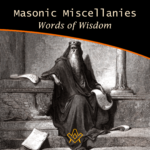 Masonic Miscellanies – Words of Wisdom Uncover timeless wisdom from King Solomon to Albert Pike in our latest Masonic Miscellanies, a treasure trove of insights for Masons. Journey through the ages and glean inspiring sayings, reflecting on their profound influence on Masonic principles. An enriching read for the enlightened. |
 Masonic Miscellanies - Symbolism of the Right Hand Unlock the enigmatic realm of Freemasonry as we delve into its age-old symbols, rituals, and philosophies. This thought-provoking exploration, drawn from Mackey's Revised Encyclopedia of Freemasonry, focuses on the iconic 'right hand' symbol - its rich history, universality, and profound significance. |
 Masonic Miscellanies - Order of the Secret Monitor Unveil the mystery of Freemasonry with 'The Order of the Secret Monitor'. Discover this lesser-known appendant order, its unique rituals, and the profound teachings it offers. Explore the bonds of friendship and brotherhood it fosters, all wrapped in an intriguing cloak of mystery. Your journey into the depths of Masonic wisdom begins here. |
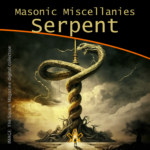 Masonic Miscellanies - The Symbol of the Serpent As a symbol, the serpent obtained a prominent place in all the ancient initiations and religions. |
 Masonic Miscellanies - The Four Veils in Royal Arch Masonry What are the four veils in Royal Arch Masonry? And what is the 'Ceremony of Passing the Veils'? Although common throughout Scotland, Ireland and the United States, it is mostly unknown in England, presently only worked in the Province of Bristol. ( and by dispensation ) |
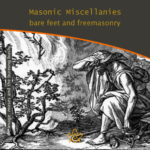 Masonic Miscellanies - Bare feet and Freemasonry A candidate for initiation into a Masonic Lodge often finds the requirements which he/she must fulfil somewhat odd. The mode of preparation often remains a puzzle, since the ritualistic explanation is not offered in full. Why are we 'slipshod' or "bare-footed" in Masonic Ritual? |
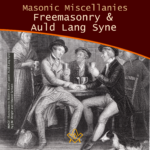 Masonic Miscellanies – Freemasonry and Auld Lang Syne Millions of people throughout the world will sing Auld Lang Syne to see out the Old Year. Few will know all the words, fewer still know what they mean, or that there is a link to Freemasonry. |
 Masonic Miscellanies - The Mosaic Pavement - why mosaic, why pavement? We are all familiar with the black and white chequered flooring of the Masonic lodge but where did it originate? There are a few theories… |
 Masonic Miscellanies – Masonic Master's Carpets Have you got a magic "Masonic Master's Carpet" in your lodge? I say 'magic' with my tongue firmly in my cheek because (as far as I know) these fabulous works of art don't bestow any mystical powers but can bestow some educational ones! However, considering their possible value today, they may magic up some interest (or funds). |
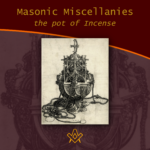 Masonic Miscellanies – The Pot of Incense Just when the pot of incense became an emblem of the third section of the Sublime Degree can not be stated with certainty. It is, apparently, an American invention or addition. But what does it symbolise? |
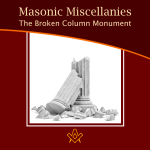 Masonic Miscellanies - The Broken Column Monument The story of the broken column was first illustrated by Amos Doolittle in the "True Masonic Chart" by Jeremy Cross, published in 1819. |
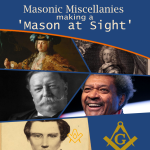 Masonic Miscellanies - Making a 'Mason at Sight' What does it mean to make a 'Mason at sight', and who was made one? |
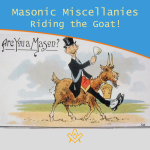 Masonic Miscellanies - Riding the Goat! Many Freemasons will have come across the phrase 'riding the goat', and will no doubt have been the butt of a joke about it (sorry, I couldn't resist!) But what does it mean and where did the phrase come from? |
 Masonic Miscellanies - What are the 'three dots'? Three dots or points in an upright triangular shape ∴ is most commonly known as the 'therefore' sign – so why is it used in Freemasonry? |
 Masonic Miscellanies - Keep Within Compass This month we discover a series of allegorical prints warning us to "Keep within Compass and you shall be sure, to avoid many troubles which others endure." |
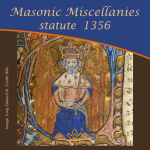 Masonic Miscellanies - statute 1356 Further to the reference in the article – The Builders - 6 - Free-Masons 'a statute was enacted against the Free-masons in 1356' – Regulations for masons who are hewers, on the one hand, and the light masons and setters on the other. |
 Masonic Miscellanies - An Anti-Masonic 'Apron'? The Anti-Masonic 'Apron' was created during the 1832 Presidential election in USA. It was not Ani-masonic. And it was not an apron. Read on to find out what and why it was created. |
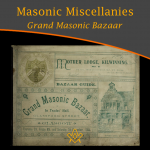 Masonic Miscellanies - Grand Masonic Bazaar (1895) Grand Masonic Bazaar (1895); to raise funds to clear the debt incurred by “Mother Kilwinning” in rebuilding their Lodge. |
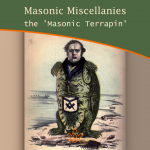 Masonic Miscellanies - the 'Masonic Terrapin' A satirical book from 1851 includes a bizarre caricature of a 'Masonic Terrapin' - all I can say is 'read on'… |
 Masonic Miscellanies - Masonic Bookplates You probably know what a bookplate is for, but did you know that the earliest known book mark/label dates from the reign of Amenhotep III in Egypt around 1391−1353 BCE?! |
 Masonic Miscellanies - Freemasonry & Bees Freemasonry & Bees - what's the buzz? The bee was among the Egyptians the symbol of an obedient people, because, says Horapollo, of all insects, the bee alone had a king. |
 Masonic Miscellanies - The mystery of the Tattooed Freemason In 1894, the body of a drowned man was found in the Bay of San Francisco - what they discovered was amazing. |
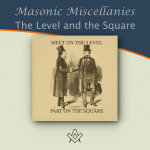 Masonic Miscellanies - The Level and the Square (A Poem) The Level and the Square (A Poem) - "We meet upon the Level, and we part upon the Square – |
 Masonic Miscellanies - The Mystic Tie What is the 'Mystic Tie'? Clue: it's not an item of neckwear! |
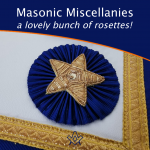 Masonic Miscellanies - A lovely bunch of rosettes! Where did the origin of the use of rosettes on Masonic aprons come from ? |
 Masonic Miscellanies - The Lodge of Sorrow The Lodge of Sorrow - Extracted General Ahiman Rezon, by Daniel Sickles, [1868] |
 Masonic Miscellanies - Memento Mori Memento Mori - a Masonic reminder to make your mark on the world |
 Masonic Miscellanies - A closer look at the Level and the Plumb-rule A closer look at the Level and the Plumb-rule |
 Masonic Miscellanies - The Symbolism of the Gloves The Symbolism of the Gloves and why Freemasons wear white gloves |
 Masonic Miscellanies - Will the real James Anderson please stand up? Will the real James Anderson please stand up? |
 Masonic Miscellanies - The Legend of the Third Degree The most important and significant of the legendary symbols of Freemasonry is, undoubtedly, that which relates to the fate of Hiram Abif. |
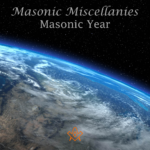 Masonic Miscellanies - Masonic Calendar Why do Freemasons use different 'years' to our regular calendar? |
 Masonic Miscellanies - What is a 'Lewis'? The English word 'Lewis' is a term belonging to operative Masonry, and signifies an iron cramp, which is inserted in a cavity prepared for the purpose in a large stone. |
 Masonic Miscellanies - From J.S.M. Ward Ever wondered why masons had to be 'free' or why we have a Tyler? |
masonic knowledge
to be a better citizen of the world
share the square with two brothers

click image to open email app on mobile device



